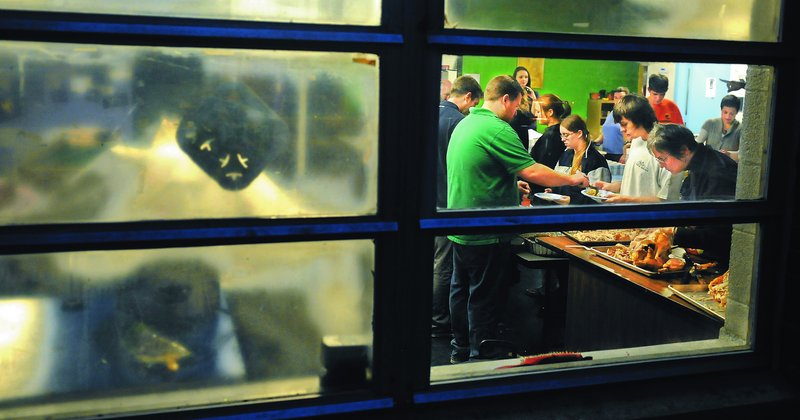– CRAIG CROSBY
Kennebec Journal
Thousands of people across Maine will wake up this morning unsure where or how they will get their next meal. People who work on the front lines to provide those meals are feeling the pressure.
The U.S. Department of Agriculture’s food security report, released last week, showed that 195,000 Mainers — nearly 15 percent of the state’s households — struggle with food insecurity, defined as experiencing difficulty at some time during the year providing enough food for one’s family.
Clara McConnell, public relations specialist for the Good Shepherd Food Bank, said the number of people who need help getting food has continued to swell since the economic downturn began in 2008.
“We’re still seeing the need increase,” said McConnell, whose operation supplies 600 food banks and pantries statewide, and delivered 12 million pounds of food in its 2009-10 fiscal year. “Our pantries are still reporting they’re seeing new families in large numbers. People have been out of work a long time and unemployment is running out. Even people who are working have been hit hard.”
The USDA report indicates that 14.8 percent of Maine households were “food insecure” from 2007 to 2009, the years in which the data was collected. The national average of food-insecure households during the period was 13.5 percent.
A total of 6.7 percent of Maine households struggled with “very low” food security during the same time period, meaning they had to reduce eating by some household members and disrupt normal eating patterns because of limited resources.
Nationally, 5.2 percent of households suffered very low security, according to the report.
The number of food-insecure households in Maine rose by 5 percent from 1996 to 2009. The number of homes with very low security rose by 2.7 percent during that period.
Maine’s rate of increase was double the national average in both categories.
Food banks across the state have shifted into high gear to try to meet the growing need, McConnell said.
“We’re doing everything we can to get food out to all the communities,” she said. “There’s hardly a community in the state we don’t serve in some capacity.”
Today’s start to the holidays promises to further stretch agencies’ resources.
The Salvation Army delivered 197 Thanksgiving baskets Monday to residents of Augusta, Hallowell, Sidney and Chelsea — nearly triple the number of baskets it handed out last year.
Cathy Pelletier, co-coordinator of the Gardiner Food Bank, cites other factors for food insecurity this holiday season.
“It’s coming up on winter in Maine,” she said. “There’s fuel, and gasoline is now over $3 a gallon. That’s going to take a toll. I don’t see us going out of business any time soon.”
If the need is greater this time of year, so is public awareness.
McConnell said she welcomes the spotlight on hunger but fears that it will be too quickly removed.
“People in Maine who are struggling with hunger are struggling 365 days a year,” she said. “It’s an important thing for people to remember.”
Capt. Matthew Morrison, commanding officer of the Salvation Army in Augusta, said the summer months and school vacations, for example, can be the most difficult.
“Children might get a meal at school, but when they’re home during the summertime, they may not get that meal during the day,” he said. “During this time of year we’re well covered. The need is there, but it’s being met. Over the summertime it’s a little more difficult.”
People tend to give more during the holidays, but donations have not always kept pace with the growing need.
Morrison said the Salvation Army’s donations have held up well thanks to efforts by schools and other service agencies.
The Salvation Army’s trademark red kettles, where donations are collected at storefronts through Christmas, continue to provide most of the organization’s funding.
McConnell said Good Shepherd is trying to work with fewer donations. Much of the food the agency collects is salvaged from large grocery chains.
As those stores have become more efficient, there has been less to salvage.
“We’re trying to be creative,” McConnell said. “We see in the community that people are very committed to helping us. We know people still want to give as much as they can.”
Pelletier believes it will become increasingly difficult to ignore the need.
“People should be aware that the person we are serving with their donations could be their next-door neighbor. It could be a family member,” she said. “It’s not a mystery person anymore.”
Send questions/comments to the editors.



Success. Please wait for the page to reload. If the page does not reload within 5 seconds, please refresh the page.
Enter your email and password to access comments.
Hi, to comment on stories you must . This profile is in addition to your subscription and website login.
Already have a commenting profile? .
Invalid username/password.
Please check your email to confirm and complete your registration.
Only subscribers are eligible to post comments. Please subscribe or login first for digital access. Here’s why.
Use the form below to reset your password. When you've submitted your account email, we will send an email with a reset code.